You might already have a good start on your survival pantry or stockpile. But you might also be overlooking some very easy items that would make great additions.
Sure, canned goods, dried beans, and water are a given. But that is where the list ends for some people.
If that describes you, then you are missing an opportunity to have a bigger variety of items and nutrition on hand for when you need it.
I have compiled a list of items often overlooked when creating an emergency pantry. These items all have the ability to add nutrition, calories, and variety to your survival. And, they have a long shelf life.
Rolled Oats
Oats are a wonderful source of fiber, protein, vitamin B6, and multiple minerals and antioxidants. In addition, oats are also easy to make and store.
If stored in an air-tight container, in a cool and dry location, rolled oats have a shelf life of about 30 years. With its nutrients, ease in cooking, and long shelf life, this makes a perfect item to have in abundance for your pantry.
Yeast
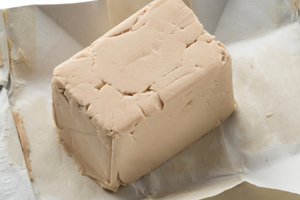 It’s great to have yeast in your pantry in order to make a variety of breads. If it’s stored in air-tight packages, it should last at least a couple years at room temperature.
It’s great to have yeast in your pantry in order to make a variety of breads. If it’s stored in air-tight packages, it should last at least a couple years at room temperature.
It’s best to store the yeast in individual packets, so unused portions will remain air-tight and sealed.
Related: How To Make Yeast For Long-Term Storage
You can either buy individual packets, or break a larger one down and vacuum seal the smaller portions individually.
Nutritionally, yeast is impressive. It contains protein, fiber, vitamin B’s, zinc, potassium, calcium, magnesium, and other minerals.
Dried Veggies
Canned fruit and veggies are OK to have on hand, sure. But, dehydrated veggies, just like fruits, have a great shelf life.
For example, dehydrated corn is good for 10 years, and carrots last up to 20 years. And, they tend to be more flavorful.
Lentils
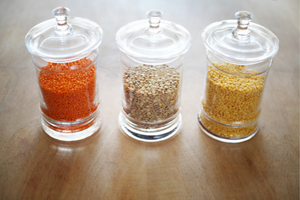 Whole dried lentils have a shelf life of up to 5 years if stored in an air-tight container. So, that makes it a great choice to have in your pantry. But, they also are high in protein, an even better reason to consider them.
Whole dried lentils have a shelf life of up to 5 years if stored in an air-tight container. So, that makes it a great choice to have in your pantry. But, they also are high in protein, an even better reason to consider them.
Related: The $1-A-Pound Food Every Prepper Should Hoard
Jerky
When people think of jerky, it’s often beef or venison that comes to mind. But, many other proteins can be made into jerky, such as turkey, salmon, alligator, and even chicken. And, jerky is a quick source of protein on any given day.
You can buy it, or make your own. If you have a dehydrator, simply follow the directions to dehydrate your choice of protein.
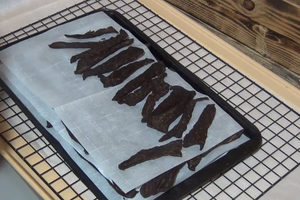
Or, you can use the oven by slicing the protein, marinade it for up to 24 hours, dry the protein on a paper towel, and then hang the protein strips on the wire rack in the oven before the oven is preheated.
Make sure to have a drip pan below to catch anything that drips.
Preheat the oven anywhere from 170 to 200 degrees. Check the meat in 3 hours, but it could take up to 8 hours.
Quinoa
Quinoa has been found in many pantries since the ancient Incas. This grain alternative is full of nutrition containing 8 grams of protein and 8 essential amino acids in just 1 cup.
Related: 10 Ingenious Ways to Keep Moths Away From Your Grains
Make sure to store the (uncooked) quinoa in an air-tight container, and it will last at least 6 months.
Dried Fruit
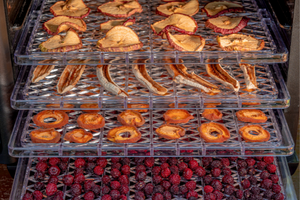 Dates and raisins are just 2 examples of dried fruit to have on hand. They are easy to find and relatively inexpensive. But, you can turn many other fruits into dried fruit for the pantry. Fruits such as figs, cranberries, bananas, cherries, mango, plums, blueberries, apricots, and more can be easily dried in a dehydrator or oven.
Dates and raisins are just 2 examples of dried fruit to have on hand. They are easy to find and relatively inexpensive. But, you can turn many other fruits into dried fruit for the pantry. Fruits such as figs, cranberries, bananas, cherries, mango, plums, blueberries, apricots, and more can be easily dried in a dehydrator or oven.
Make sure to store these dried fruits in an air-tight container. If stored properly, they can survive on the shelf for up to 5 years.
Coconut Oil
Coconut oil is great to have on hand because of its high tolerance for heat while cooking, unlike butter and some other oils.
When not heated, it remains in a solid form and has a shelf life of at least 2 years if stored properly, in a dry and cool area.
Chickpeas
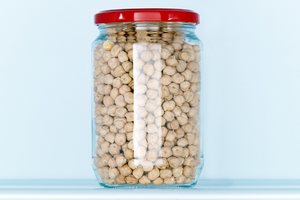 Chickpeas, or garbanzo beans, are a protein-rich food item that will add texture, flavor, and nutrients to a meal. And, if stored properly in an air-tight container, the shelf life is an impressive 30 years or more.
Chickpeas, or garbanzo beans, are a protein-rich food item that will add texture, flavor, and nutrients to a meal. And, if stored properly in an air-tight container, the shelf life is an impressive 30 years or more.
Related: Cheapest Foods that You Can Stockpile
Honey
I’m not going to lie, this one surprised me. I don’t know how many jars of honey I have thrown out over the years, thinking it had gone bad because it was crystalized.
However, I now know that we shouldn’t throw out a perfectly good jar of honey, even if it’s crystalized. All you need to do is slightly warm it and stir and it will go back to its natural state.
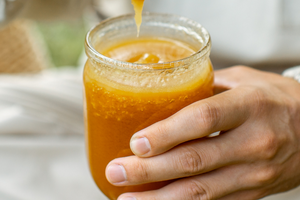 Honey is a great addition to your pantry, not just because it tastes good and can be used to sweeten food and beverages.
Honey is a great addition to your pantry, not just because it tastes good and can be used to sweeten food and beverages.
It also has a lot of healthy attributes to it as well.
It can boost your energy, or soothe a sore throat and calm a cough.
Related: 23 Survival Uses for Honey that You Didn’t Know About
Honey can also be used to help with wounds due to its natural antifungal and antibacterial properties, and will boost oxygen for healing wounds.
Look for 100% pure honey, and store it in an air-tight container. It will probably be used up long before it goes bad.
Nut Butters
You might have already considered peanut butter because it’s a common staple in most pantries. But, there are other nut butters you may want to consider.
Almond butter and sunflower seed butter are easy, quick, and healthy sources of nutrition and energy. You can find them in stores or make your own.
⇒ How To Get 295 Pounds Of Extra Food For Just $5 A Week
Properly closed jars of nut butters can last in the pantry for years.
Kamut
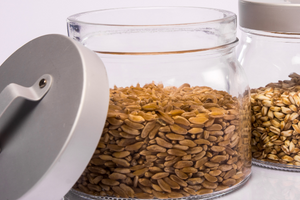 Kamut is a grain that is often overlooked. But since it’s easy to digest, and offers at least 40% more protein than wheat, it’s a great option.
Kamut is a grain that is often overlooked. But since it’s easy to digest, and offers at least 40% more protein than wheat, it’s a great option.
It has the reputation of being a “high energy grain”, with its high level of lipid. The shelf life is consistent with other grains.
Pasta
Pasta is a good source of carbohydrates, which is necessary for a balanced diet. It’s lightweight for storage and can have good flavor with various seasonings.
Unopened dried pasta can last on the shelf for 2 years, while opened can still last a year. In addition, it’s an easy addition to soups and stews to make it more filling.
Nuts
I often turn to nuts when I’m in a short and temporary survival mode, such as being at an all-day event with little convenience for eating a meal.
And, I carry little bags of nuts in the car, in case of emergencies. So, this might not be an overlooked item for some, it might be for others who don’t love them as I do.
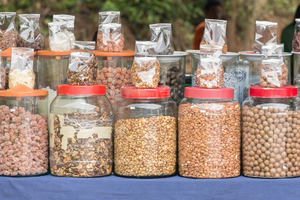 They have a lot of protein, are easy to store, and are easy to eat. Peanuts are relatively inexpensive when it comes to nuts.
They have a lot of protein, are easy to store, and are easy to eat. Peanuts are relatively inexpensive when it comes to nuts.
But for a variety, other nuts to have on hand include pistachio, walnut, pine nut, corn nuts, cashew, macadamia, almonds, and hazelnut.
These all are good sources of protein, fiber, and necessary fat. Along with being a good source of protein, they are also rich in zinc, fluoride, selenium, iron, magnesium, potassium, and antioxidants.
If they are stored properly, in air-tight containers, they have a shelf life of 12 months.
Sugar & Salt
Sugar and salt don’t offer much in the nutritional area. Some would argue they do the opposite.
However, a little bit will go a long way in adding flavor to a meal, and that is also important because a lot of survival foods tend to be on the bland side without it.
⇒ What Happens If You Pour Salt Into A Cabbage
Salt can also help preserve other foods, such as meats if you rub salt over it. When stored properly, sugar can last up to 2 years, and salt 5 years.
Maple Syrup
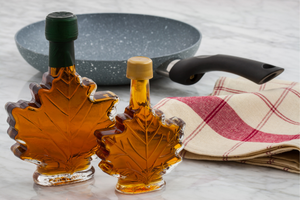 Maple syrup can add a lot of flavor to foods, and replace sugar as a sweetener. And, it has more calcium than milk, as well as zinc, potassium, and iron.
Maple syrup can add a lot of flavor to foods, and replace sugar as a sweetener. And, it has more calcium than milk, as well as zinc, potassium, and iron.
The perk of maple syrup is that you can forage it from a maple tree yourself if you have them in your area.
An unopened bottle of store-bought maple syrup will last about a year. An opened bottle should be kept in a refrigerator if possible.
Alcohol
Alcohol is often overlooked as a survival item. But it has far more perks to it other than just having a drink. It can be used as fuel when using a compact alcohol stove. It also works as a disinfectant for wounds or tools.
Related: 10 Medicinal Uses Of Alcohol You Can Benefit From Right Now
To improve the shelf life of fruit, soak it in alcohol, such as vodka, rum, or whiskey. An unopened bottle will last forever. Once it’s opened, it still has up to 2 years on the shelf without going bad. And even then, when it comes to alcohol “bad” typically means losing some color and flavor.
Potato Flakes
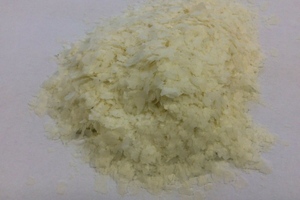 Instant potatoes are a great addition to your survival pantry. They are very easy to make, and the flavor can be altered for variety.
Instant potatoes are a great addition to your survival pantry. They are very easy to make, and the flavor can be altered for variety.
Eat them as intended, change them into a soup, or use them as a thickener for other dishes. You can also turn the flakes into flour for making bread.
Unopened packages of instant potatoes will last on the shelf for up to 15 years when stored properly in air-tight containers. Once opened, the shelf life is between 6 months to a year.
Nonfat Dry Milk & Powdered Milk
Nonfat dry milk has a very long shelf life of 20 years. Unfortunately, it doesn’t taste all that great. But, the nutritional value makes up for the lack of flavor. It has a nice balance of fiber, carbohydrates, sodium, and potassium.
On the other hand, powdered milk has a much better taste, and is also nutritious. It is rich in vitamin C & A, iron, zinc, and calcium. The downside to powdered milk though is the shelf life is much shorter at 2 years for an unopened package.
Apple Cider Vinegar
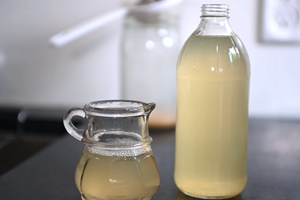 In addition to having a very long shelf life, apple cider vinegar has many health benefits as well.
In addition to having a very long shelf life, apple cider vinegar has many health benefits as well.
Its antioxidants can help with fending off viruses, improve gut health, soothe an irritating cough, and rumor has it that it might aid in lowering cholesterol.
Cornmeal
Cornmeal can be used in place of flour. But, you can also use it to make corn tortillas, without needing yeast. Some people also use it to thicken soups and dishes and add a corn flavor.
Cornstarch
I’m adding cornstarch to the list because it will last forever, and can be more than just a thickener. It can also be used to clean, deodorize, repel insects, and soothe an irritating rash.
Powdered Drink Mixes
Powdered lemonade and other powdered fruit drink mix not only can sit on a shelf for years, but they also can add a variety when it comes to keeping yourself hydrated. And, many of them have vitamin C added.
The above list consists of items that are common in most kitchen pantries. But, you might not have considered their value when thinking of your survival pantry. Hopefully, this will help you in adding variety, nutrition, and longevity to your stockpile!

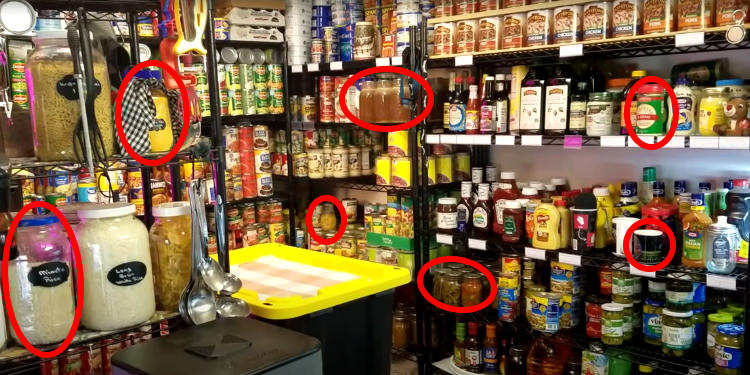













Lol yeah you sure can forge maple syrup from a tree. Who writes this trash has no clue how labor intensive it is.
Plus I make some of the best nut butter around
I suspect some of the ideas in this blog are more ‘theory’ than ‘practice’. I might go YouTube how to get syrup from a maple tree, could be interesting! (They are not local to my area, so this is purely theory/academic for me, if I want some sweetness in the wild I could find a native bee hive in an abandoned ant farm, or follow any other bees to a hive, or eat a range of bush foods.)
Well the honey is also wrong. Pasteurized honey is not going to last.
LMAO. “Just follow some bees”. Oh ye of zero experience. Good luck with that idea. Even if you could manage to track the bees, they won’t be at all willing to share. Let me in on the attempt, I’ll film it for AFV! (used to keep bees)
common misunderstanding about tree tapping for spring sap >>> plenty of other tree species besides the various maples – birches are actually a great source for an elixir for vim & viger & health >>> it helps if you prep specifically for tapping & sap collection but you can most certainly DIY using improvised materials ….
LInda, don’t knock it, until you know whether I’ve tried it 🙂
Gosh some people in this blog are so full of drama and snark. I’m not sure why there’s a need to tear each other down so much, does it make insecure people feel more important? Certainly helps us remember “not all preppers are people you want in your group”!!! There’s some really borderline creepy angry people in this blog, and it’s probably going to drive away a lot of very sensible people. I’m not sure why the moderation lets this stuff through, maybe it’s time to move this to a registered user commenting space?
(Oh, and LInda, I live in a part of the world where the native bees are renowned for not being aggressive, and where, if you work like the indigenous people have, you can literally reach in and break off honey comb from the hives, inside abandoned ant hills or other structures. Yes you can go after the common imported bees honey, and yes some native bees sting, but why when you can also track down ‘friendly bees’? Many native plants have very high rates of nectar and seasonally you can eat quite sweet too. The snark wasn’t necessary and just showed you as unpleasant, and a person who makes assumptions. I don’t know why people in this blog do that, they don’t seem to in other prepping blogs, maybe the culture here is kind of trashy?)
Well Sandgroper, when your safflower oil goes rancid and you want an oil to make a salad dressing or some other food, what will you use then? When you have a cut or an infection and there’s no doctor, what will you use as medicine then? There’s much to learn about how many amazing things that coconut oil can be used for besides (and including) food. This is about prepping for a SHTF or emergency situation, and we might all need to eat or try foods/things that we aren’t used to. These are heartfelt suggestions to those who are interested in learning new things. Store bought chips and cookies won’t be a staple food in such emergencies, as we recently experienced in Florida with Hurricane Ian. It seemed that those shelves were the first to empty out when the stores reopened. You don’t have to take these suggestions, but please be kind and thoughtful to the one who presented the idea to us who are willing to learn about such things are are wanting to survive a SHTF situation. I’m very grateful for his suggestions and his generosity in sharing his knowledge and experience.
Pasteurised honey? There was no mention of it in the article. I buy mine by the bucket from our local beekeeper.
I grow sugar cane and had seeds for sugar beets at one time. Can’t find them these days but both grow well here. Another is sorghum. Carob for chocolate substitute, honey still my favourite.
Sandgroper, exactly. We call them drama queens, like heavy-duty and lindain. As fer me, I like mesquite pods cooked down for syrup. We can raise sorghum easily enough, as well. Cut before going to seed makes surgum come back to be cut again. We have stingerless honey bees, but they’re very small. For the bigger ones you would need to go to Mexico, the hot lands. Arizona bees are all Africanized. But, I’ve never been stung. Proof of that is, I’m still alive. Docs say I’m majorly allergic to them but love them anyway. niio
We do small batch maple syrup every spring. It’s not difficult. We cook it down in a propane turkey fryer, but you can do it over wood fire too, with a few bricks and some wood.
you tap the tree for sap in the spring, it takes 32 gallons of sap to make 1 gallon of syrup
Don’t see where you call that TRASH…it might be a little labor intensive BUT…it can be done in an emergency…I tapped a couple of Black Walnut trees and made a little Syrup …its not like someone wants to put a stand up and start selling the stuff….it’s just a idea where you can get something to provide substance’s
The lack of how to… you’re not just tapping a tree and getting syrup. It’s requires a bit of tools and heating oven. I have the setup and it’s 40 to 1 ratio.
I think it is called Sap before it becomes Syrup.
Yes, very labor intensive, but, by a good skilled man, it can be done. Or women…
Remember if you do not bend, then you will break. Bend a little, it’s called survival.
stay sharp
Rather than learning the hard way, I found that taking the time in advance to do small steps first, goes a long way in the learning process when one wants to acquire and hon a skill set. Like any difficult problem or protect, it pays to first break it into small manageable steps to get the skill set in place to get the job accomplished. When the folks here share those experiences, it is most helpful to everyone interested in reading these articles
It’s not that labor intensive – spike a tree, collect the sap in a bucket on the end of the spike and boil it.
Lol sure if you make a cups worth
It takes about 26 gallons of sap boiled down to make one of syrup. A little labor intensive. but if the SHTF it might be worth it.
It takes 40 gallons of sap to make one gallon if syrup
I swear we could lead you to water and how to drink. Yet you people would die if dehydration.
Boiling is not “labor intensive “. Collecting sap is not “labor intensive “! I suspect you’re confusing time with labor.
Dong / Farmer
If one does not know how to spike a tree, in order to collect Sap and then gather the sap and then put together a fire and then start to process the liquid into Syrup and without scorching it.
Know, I am talking about someone that has not the learning and or Information on how to. Then YES, this would be very labor intensive to that person.
Most all things are labor intensive, when you do not know how to.
You have to start somewhere.
crawl then stand then run… Just time, that’s all.
stay sharp
Cute you make a quart on the kitchen stove. You need about a cord or more of wood.. sap isn’t light by nature and it doesn’t just boil it self. But hey go enjoy the burbs
Yes, it’s fairly labor intensive, as well as seasonal, but in no way is it out of the question to those who have maple trees available.
Generally, the readers here (preppers) are already somewhat experienced, or at least well-read on self-sufficiency, so probably know if they could take advantage of maples. In areas where maples are plentiful, tapping trees for syrup is still standard practice (at least in my area), and finding knowledge and equipment would not be too difficult.
Oh, and enjoy your nut butters, which probably have the shortest shelf life of most items listed here – no comment on that?
cindy, Nut butters are made as needed. Very labor intensive but worth it. An adjustable bell sheller makes it a lot easier. For peanuts, we’ve used a grain grinder set wide enough apart. The bell works fast and better. Nuts that are roasted first are easiest to shell. The bell sheller was invented in Africa for peanut farmers. It’s a bell shaped rock or concrete (do not use sand) that a bell shaped hollow piece sits over. A hole in the top is for the nuts. Adjust the upper part so it’s a little bigger than the nuts. niio
100% red ant. Whether maple or any other kind of tree sap, syrup is just thickened tree sap. Thickened by boiling the water off. Not particularly labour intensive but rather energy intensive. That’s why it’s so expensive. 40:1 ratio. It’s nice when you’re first making it. You HAVE to test it. When you think it’s gotten thick enough you ladle a little out of the cauldron and throw it onto the snow. Very nice.
Candy thermometer works better
Armin, mesquite and sorghum! yum! niio
Slick…you’re not winning many friends by being overly critical, surly and pedantic. This blog is for people who want to discuss serious prepping topics. We appreciate your seemingly vast knowledge but your delivery leaves much to be desired. Why don’t you try a different approach?
This is meant for the Chevy guy
Some info on maple syrup making,
Tools required, types of maple trees, etc…
Good luck to anyone pursuing this adventure!
Maple Syrup Production for the Beginner
Gotta ask, where in Arizona do I find a maple big enough to tap? Yes, I know how because when in Penna we made our own. Sorghum is easy here but it can carry dwarf maize virus. Mesquite is the easiest. Dates are good and so on, but all 3 varieties of maple here don’t get heavy enough to tap.
I have 40 acres of them here in Northern Michigan.
Sonny, it’s not sandgroper, but the drama queens that are acting weird. Aussies here are respectful and respectable.
We prefer animal fats because they’re healthier–modern dieticians agree. In case we ever do need veggie oil, chia is the best. Any veggie oil can be made by covering a pot of crushed seed with water and simmering for hours. If you have a small stainless steel distillery, it’s even easier. They can be bought for 50 bucks. What remains is used in stews or dried. niio
I always wonder why sugar or salt is perceived to ‘go off’ after a period. Do these really have a shelf life? Isn’t it air exposure that is the issue and storing them sealed is likely to resolve most of that?
I had no idea chickpeas could last that long… interesting. Some of the other foods seem rather short in lifespan for me, and if they aren’t part of my regular diet I wouldn’t bother – such as coconut oil – I don’t use it often day to day, so adding it to a stockpile seems fruitless.
I have Himalayan salt which of course has been in the ground for a while….millions of years. The package has an expiration date 2 years down the road. I wonder if I should throw it all out?
Funny
No – DON’T throw it out. Package it (a glass jar or maybe plastic bucket) and it will keep forever – literally! If you make sure nothing can get in to it (dust, bugs etc) it will still be good. It’s an awesome preservative, good for making veggie ferments, and provides many of the trace minerals our diet is lacking.
Earth is less then 8000 years buddy
I think it’s really ‘funny’ that slat that has been around for millions of years “expires” in 2 years. It’s salt for heavens sake. The company who sells it is hoping you are stupid enough to throw it out an and buy more.
OK, for all you people below that need a refresher… take a chill pill. If you don’t understand satire … then you really need to read more carefully.
Actually, adding coconut oil isn’t a bad idea. I purchased it (and used some of it) years ago. Seems that even if it liquifies and/or freezes, it still stays good. I’ve had some containers (hdpe buckets) for 8 years now and the oil is STILL good. I have a very sensitive nose and taste buds, know when oil is rancid, and this stuff is GOOD. A VERY good company to buy from is Tropical Traditions. I’m not sure how shipping is going any more, but if you can get your hands on some it’s a good way to go. As far as things like dry legumes (beans, chickpeas, lentils etc), they have NOT lasted. And anything that is cracked open (like nuts) goes rancid rather quickly over a year or if the temperature is above 40 degrees F. Not a good long term storage item. If you can, burying it in the ground (in buckets and plastic to keep it weather tight) worked for us. Even the trail mix and jerky were still fresh after three years! Amazing!
Salt never expires.
Iodized salt – the iodine does expire
Calm down, it’s a satirical comment!
So many so called Christians here and yet nobody else seems to call out the bs on millions of years
Probably because nobody wants to hear your gibberish. This site is for intelligent people to discuss survival topics. While I’m sure that you are convinced that your comments are worthy of pages of discussion, none so far have related to the instant topic. If you have something intelligent to add to the topic, by all means do so. Otherwise, I’m sure there are a plethora of sites where you can pontificate to your heart’s content.
HD/Raven. Right now, so what if the universe is millions or only thousands of years old. As a Christian for many years, I doubt God really cares. I started out as an atheist, went to old-earth Creationism, and am now YE because of science. Believer or not, we’re all in the same leavy boat surrounded by greedy sharks. Tap your helmet and get in the game.
@ Heavy-duty Chevy I’m not exactly sure what you’re trying to say. Whether you’re making a joke or whether you’re trolling us. If you’re talking about the age of the earth you do realize it’s been approx. 12,000 years since the end of the last ice age. In total the earth is approx. 4.5 Billion years young. Our parent star is now middle aged and having a mid life crisis.
Yah and his word would disagree
Sandgroper. Like any other ‘grain’ chickpeas and all legumes need to be frozen for a while, a few days, or weevils will hatch in them. Yes, legumes can be kept for years but will dry out. Than, they’re used as flour. Any fats can be frozen, as well. But, look up the health bennies of coconut oil. Excellent. niio
I guess everyone is entitled to their own opinions, however trash talking isn’t helping anyone trying to at least feel safe after SHTF. If ya don’t use the stuff, don’t buy it, that is unless you’d want it as barter. Damn, people wake up. Sounds like a democrat.
Most of these are pretty common staples for anyone prepping for emergencies. Oh, and peanuts are not NUTS, they are legumes.
Valerama, yes, but called nuts. 🙂 niio
Chuck
Abondance’s of the heart, the mouth shall speak.
Turn your heart away from this that you speak. You are better than that. So please reframe yourself from this vomit that you are spewing.
We hope that you will give us something to help us survive.
We all know that this earth is full of stupid so-called people.
Give it up.
Let’s talk survival…
Hey, are you going to vote or are you okay with this life that we live today. ?
@red ant The Democrats won’t give up their positions easily. They’re desperate and they realize they’re done.
Armin: That’s why they’re demanding a new war with chicoms. We’re at war with Russia, and liberals need one where body bags pile up to make more money and CYA. niio
Yes, I’m preparing for a siege. May stop at the store for a few more things. Look at what you have and think empty G Store. Maybe i’ll raw can some fresh rabbit. Have so many 5 gal buckets w/ the proper lids.Time to fill them. Already have the oxygen absorbers and too many sealing bags.
On the list, a couple i hadn’t thought of, Winco bulk bins are really close. D-day is 11/8th.
They will burn you out
Again … there are plenty of websites and blog sites where you can discuss deviant topics. Your time might be better spent there. You can discuss Biblical truths, abnormal sexual behavior, maple syrup making techniques and a full range of other interesting topics. Go there!
That’s one of my worst fears. If the marauding gangs aren’t successful in gaining access to your house they just might throw a couple of Molotov cocktails into the house and then you’re done.
Armin: We’re in Indian Country. If they try, there are dozens of people ready to open fire. But, a fire extinguisher in every room is a plus. niio
I have 18 of the listed 23.
I’ll work on the remaining 5.
I don’t know if it’s been listed, but I’ve squirreled away several bags of each different split peas also.
Green, yellow, and “almost” orange coloured split peas…
Just for variety’s sake.
And warming crystallised honey should be done in a pan of warm water on the stove, slowly.
Never in the microwave or direct heat!
I have tried it in a microwave with great success. Just set the microwave low and then heat the honey in 30 second increments. Anything with water in it takes a great deal of energy to heat. That’s principally what I use the microwave for. To heat water. It’s a very effective tool for doing that. Don’t like cooking with the microwave. Food turns out……”funny.”
While the information is fine, the title is another one that is way off base. Many, if not most, of the foods listed are stocked by huge numbers of preppers and have been for years.
I suppose it it nit-picking, but so many of the titles to the articles here are very misleading at best and completely incorrect at worst. Trying to entice people to read the articles I think, which is a common marketing tactic in today’s society.
I was raised as a whole truth and nothing but the truth individual and it bothers me to see good information somewhat diluted in concept by misleading article titles. People come in to read about something that the title indicates they are not likely to know, yet when they get here it is relatively common information which many people do already know.
This actually lessens the likelihood of someone coming again, figuring that the next article title is the same type of misleading title that will have information they already know.
Just my rather ranting opinion on article titles. Not too helpful with storage foods I know.
Jerry, this site attracts a lot of people new to prepping, so expect a lot of ‘we already know that’. niio
The other day I took some leftover mashed potatoes (could make from potato flakes) and added cornmeal and eggs and a small amount of baking soda (from my chickens) and fried them in vegetable oil. Made fried and light bread without any white flour at all! Baking soda lasts forever and so does cream of tartar and together they make baking powder (which doesn’t).
How do you get baking soda from chickens?
That’s what I was wondering lol!
Ask them
@farmer Easy! Just trade them some chickenfeed. 😉
Farmer, yeah, but then I remembered old-timers would burn eggshells for the calcium carbonate. It works well, young man 🙂 niio
Here is something I came across twenty odd years ago and it does work. To make powered milk taste better, add 1 tablespoon Canola oil to 1 quart reconstituted powdered milk and shake vigorously for about a minute. You now have basically 2% milk. Canola oil gives the best flavor.
US Armed Forces use this when suitable milk supplies are not available on lhe local overseas market.
artificial vanilla is cheap – add a slug to the mix and it’ll be more milk tasting than when it exits the udder …..
I wouldn’t use canola oil…it is very highly processed, not earth friendly as it takes so much electricity to make it fit to consume, and it usually GMO. (it’s called rapeseed, and it has been genetically modified by adding roundup to its genetic material) Now, I know this isn’t usually an organic blog, but if you are thinking to keep healthy, you don’t want to be putting toxic ingredients into your food…There are many other good oils you could use: avocado, which has great benefits, coconut oil although it might give off a coconut-ty flavor, probably not olive, as it is a pretty strong flavored oil, etc..
But I agree, FAT FREE powdered milk would be a bit better if some healthy oil was added to it.
(funny story: years ago when I babysat a college prof family, they used powdered milk. I had never had it, but when I smelled the pitcher, I thought it had gone bad and threw it down the sink! I did this TWICE!…oops!)
Hey Carol. I’m also not very keen on Canola. Seems to have a funny taste in the background. Maybe fishy? My go to oil is sunflower. To me a good compromise. While not the best but still one of the better oils and at the moment not overly expensive. This blog is whatever we want it to be, Carol. It’s supposed to be a safe space where we’re free to discuss whatever the heck we want no matter how much some of the trolls like to think otherwise. If I don’t like the subject matter I’ll start a discussion on something else with red ant, or red, or LCC or Miss Kitty, Very easy way to deal with trolls. You just ignore them and don’t include them in any discussions. That’ll be the day that some SOB tells me what I can or cannot discuss. They don’t have that right. Here, especially, freedom of speech should be honoured and cherished. Hey, red ant, nice to see you here. Don’t have a lot of time right now for long posts. Things are heating up in the real world quicker than we thought. Now is the time to get as many of your last preps as you can. 2022 was supposed to have been a cake walk. They’re predicting ’23 to be a real little bugger. As preppers we never think we have enough and there’s always those one or two items we miss. Get ‘er done. NOW!!! PREPARE! PREPARE! PREPARE!
Carol, I don’t use canola oil either but I must point out that not all canola is GMO. Many varieties are open pollinated traditional types. There are quite a few GM varieties though but originally canola was selectively bred from rape, not tinkered in a lab.
At least, that is still the case here in AU. Not all modern farmers have taken to the GM trail. We will never grow GM anything , haven’t planted any canola at all this year.
Jerky from “…alligator, and even chicken”. Not sure what part of the country you’re living in, but where I live those would be reversed.
Um, no alligators. I guess they don’t like our gentle Arizona sun. niio
Some of you are right, some of you are wrong, all that matters is that people are reading and sharing and learning from each other. Isn’t that what its all about friends.
I have a question…. The major thing about “shelf-life” is a cool, dark storage area. Many prepper sites and books talk about rout cellars and basements. Does anyone have a suggestion for people in SW Florida where we literally stick a shovel into the back used and hit the water table with the first shovelful – especially in the rainy season. I tried to bury a 50 gallon barrel but ran into so much water that I couldn’t dig a hole deep enough. I tried this in winter (our dry season and hit water 4 feet down. If I were able to succeed I had a couple other consents 1) condensation on the inside of the barrel, and the fact that all of our quarter acre lots have septic tanks in them. When SHTF, there will be no AC and our summer regularly run into the 90’s on a daily basis for months and months. So there will be no “cool” place in the house to store foods. Things won’t have much of a shelf life in the Florida heat. Anyone have any ideas?
EXCELLENT COMMENT! You’re right on the money. That IS what it’s all about. We can discuss anything on this page with anyone as long as we keep it civil. The ruling elite would like nothing better than to have us fighting each other. Save them the trouble. Why do you understand while so many don’t and just let their egos get in the way and cause trouble because they have no other outlet for their fear. Right now the unprepared are starting to realize just how serious the situation is and they don’t have the time nor money anymore to become properly prepared. The last great depression lasted a decade. This coming one could be worse.
Pure, unheated raw honey NEVER goes bad. It may crystalize, but if you heat it under 100* it will melt back. Over about 109, you loose all of the healthy enzymes. There is no need to pasteurize honey. Honey has been found in Pharaohs tombs that was still good.
You can tap other trees for ‘syrup’…It does take a lot of work to make the liquid from trees into thick syrup, but you can still use the liquid that comes out. It is said to be refreshing and slightly sweet and healthy. (the syrup is just boiled down to thicken it) I have not done it, but I have tasted birch syrup…good.
Neither commercial sugar or salt will go off…it will however solidify if it gets moist. So, yes, air and moisture is not good.
As for nuts, leaving them in the shell will considerably prolong their life. What you have to watch for is the oils: the oils go rancid after awhile. Oddly, not nut butters, they usually last a long time.
I have read that dried beans and legumes, although they last a long time stored, will eventually get to the point where they won’t soften when cooked. That’s why some suggest after several years, you prepare and can them.
Rolled oats are good, but steel cut oats are better for you.
You can “catch” yeast from air. it’s called sourdough.
Most fruits also have wild yeast growing on them.
Look it up.
Foraging for Wild Yeast
2 Foolproof Ways to Capture Wild Yeast
I posted this about 8 hours ago…not sure why it didn’t go through…
100% Carol! Honey and salt are both preservatives. Have never heard of honey going bad. As for peanut butter it IS the oils that become rancid not the peanut butter itself. And the oils being lighter they float to the top. Even though I’ve made sure to store peanut butter in a cool dry place, no matter what I do after a certain amount of time the oils DO become rancid. Unpleasant to eat. So instead of tossing that whole one-litre jar I just unseal it and take off the first half inch of peanut butter making sure to get all the oils out. After that it’s fine to eat. I’ll be darned if I’m going to throw out all that peanut butter. And then I just use the peanut butter and oil that I’ve gotten out of the jars to feed our wonderful woodland creatures. Especially our squirrels. They’re so darn cute. 😉 Just to be a little picky Carol I don’t know if the wild yeast itself is called “sourdough”. As far as I know “sourdough” is the name of the starter that’s left over after you finish making bread. To keep it alive and be able to use it to bake that next loaf of bread you have to “feed” it every day. Doing it like this you can almost keep that starter alive indefinitely.
Oops! Forgot something. Yes, I’ve found the same thing. Keep legumes and all your dried goods long enough and they do seem to become quite stubborn. I do love my barley and even at this point it’s becoming quite difficult to cook it. So the next thing I’m going to try is cooking them in my insta pot. The added heat and pressure SHOULD break them down. Famous last words. 😉 We’ll just have to try and see.
Armin: When any grain/legume reaches a certain age, you’re best bet is flour. But, let us know how the instapot worked out. niio
I had some old beans I used for baked beans. Soaked them overnight, slowcooked in the oven for six hours. Tasty, but al dente. Reheated some next day, and still al dente.
Decided to freeze the rest in small amounts (1-2 servings), and use them up over a few months. Maybe three weeks later, I took out a package, thawed it, and reheated. The beans were perfect..
I’ve not had such old beans to use since, but if I do, I’m cooking then freezing. Might try pressure cooking them to see if the al dente goes away. If not, then cook, freeze, reheat.
The articl does say 100% pure natural honey. Not processed or pasteurized
Refined coconut oil doesn’t taste like coconut
Not sure if many know this or not. I didn’t the first time. You Have to rinse Quinoa until the water runs clear, before cooking it. Has a VERY bitter coating that Has to be rinsed off before cooking or you will never want to eat it again.
I bought some because of the protein content. Cooked it and No One would eat it. Thought oh great, just wasted time money and dinner, lol.
Then my SIL served some in a salad and it was great . She said no matter what colour ya buy, it has to be rinsed.
Hope this helps someone else.
Peace,
MadFab
Always a pleasure to hear from you MadFab. 🙂 To me quinoa is something rather exotic and in a true SHTF scenario probably rather quite pricey. I like to abide by the KISS principal and eat things that I know. People can do and eat whatever they want but I’ll stick to my peanut butter. Baked beans. Rice. Pasta. Rolled oats. Etc. Get ready for an earthly purgatory. ’22 was NOTHIN’! ’23 is going to be WAY more interesting! As a small aside when I first came across quinoa I thought it was pronounced kwin-no-ah. But no, no, no. We must never forget this is the English language and nothing is pronounced as it’s written. Imagine my surprise when I found out that grain is pronounced something like keen-wah. Sheesh! Who knew!? epitome? ep-i-tome? 😉 Just as an FYI qunoa is a pseudocereal related to spinach and amaranth. Have a great weekend MadFab! 🙂
Armin,
Was happy to see ya commenting. So many have stopped commenting.
Sure miss the comments of LCC. Red and Clergylady show up once in a while and I really.like their comments.
Haven’t seen Miss Kitty in a month of Sundays.
Michael and CityChick are still stopping by, but unfortunately, just like the times we are in, things are getting more tense and terse.
Hoping we all are getting what we can for the coming times.
I also like KISS, but I am trying to get as much protein stacked as I can. Have growing grandboys, and they have developed the dreaded Hollow Leg Syndrome. Lol ?
Keep up the good work, all.
Peace,
MadFab
Did NOT mean to suggest that Michael and CityChick are terse. Was suggesting maybe that was why they don’t stop by as much.
Peace
MadFab
Sunny….valid points all. I’m always “irritated ” at the suggestion “store between 50 and 70 degrees “. Nowhere in my mississippi cabin is it 70 degrees much less 50 any time of the year. Winter is the closest when I keep the place at 65 to 68 with a wood stove. Most of my dry foods…rice, pasta, beans…is stored in outbuildings…hot in summer and bug killing cold in winter. Upshot is…I don’t know the answer.
For some reason, I’m not getting replies to posts. If you don’t hear from me, blame that.
Like mad fab said, KISS. We don’t do a lot of gain or legumes. Raw dried beef is $30.00/pound at a nearby tienda. But, it’s well made with no fat.
Wayfair carries several sizes of stainless distillery pots, and making veg oil in them is easy enough. If you want distilled water, buy a second one. This is Arizona and safflower is a commercial crop. It’s about predator proof because it’s a thistle, so plan a way to harvest and remove seeds. We use an old food processor to break up the seed heads, but it’s a slow process, and something more needs to be done.
Salt, honey, and sugar will last forever if kept well. We don’t buy a great deal of sugar, but like honey. Stored salt is is 50# sacks, and needs to be melted, then brine poured off (to get rid of impurities) and dried.
We grow some dates, but sorghum would be a major sweetener, as well as honey. Mesquite pods are be boiled down for syrup. niio
I don’t know that overlooked is as accurate as just plain good list to start with. These are the things to start putting away after you move beyond rice, beans, and wheat berries. I stock everything but the quinoa and kamut. I keep some triticale, it’s a variation of wheat/rye. We always have nuts, but they stay in the kitchen. I would be concerned about them going rancid if they stayed in the deep pantry for several years. Another thing I do different is my extra yeast stays in the freezer along with my ghee, lard, and Crisco. Some might say these don’t need the special treatment but I want to be sure I have some usable fats. Overall I rate this as a good starting point especially for someone just getting started.
Sunny, I have wondered that as well.. Digging into a hillside can work, but everywhere I visited in Florida was flat. The only other thing I can think of is building a cold room like a spring house. Or something like an adobe type building with thick walls and stone floors and keeping foodstuffs in insulated containers.
Sweet gum is a southern sap tree that can be tapped year round for syrup. This fact isn’t widely disseminated in the preparedness community.